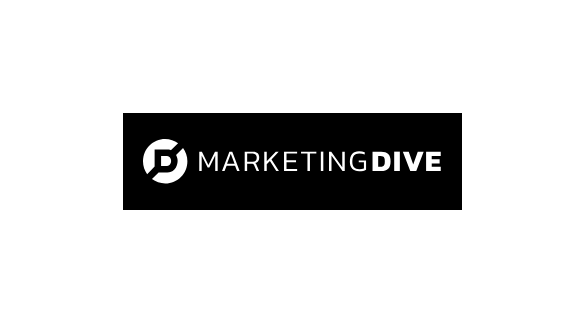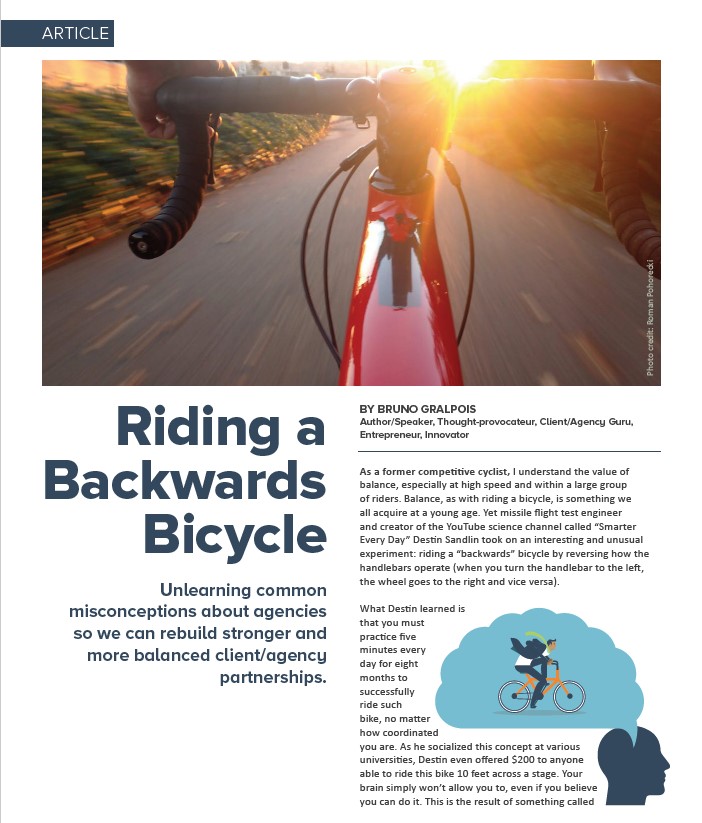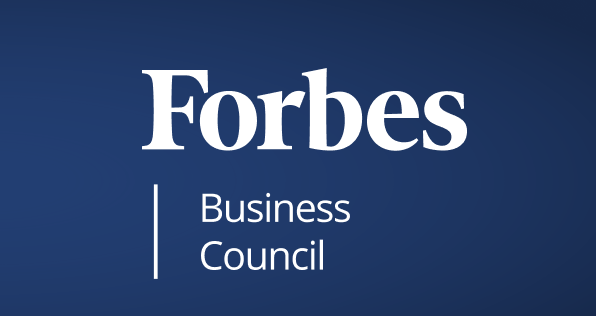Featured on Marketing Dive:
Marketers have been conditioned to accept some ideas that eventually threw us off balance. Ultimately, these false ideas get in the way of effective partnerships.
— Read the published Marketing Dive article —
The following is a guest post by Bruno Gralpois, co-founder and principal of Agency Mania Solutions. Opinions are the author’s own.
As a former competitive cyclist, I understand the value of balance, especially at high speeds and within a large group of riders. Balance, as with riding a bicycle, is something we all acquire at a young age. Yet missile flight test engineer and creator of a YouTube science channel called “Smarter Every Day” Destin Sandlin took on an interesting and unusual experiment: riding a “backwards” bicycle by reversing how the handlebars operate (when you turn the handlebar to the left, the wheel goes to the right and vice versa).
What Sandlin learned is that you must practice five minutes every day for eight months to successfully ride such bike, no matter how coordinated you are. As he socialized this concept at various universities, Sandlin even offered $200 to anyone able to ride this bike 10 feet across a stage. Your brain simply won’t allow you to, even if you believe you can do it. This is the result of something called neuroplasticity, the ability of neural networks in the brain to change through growth and reorganization. Apparently, some things like riding a bike are cognitively more challenging than you might think, especially when you change a simple variable like the gear.
As marketers, we have been conditioned to accept some ideas about agencies — business variables, if you will — that eventually got us all out of balance. Ultimately, these false ideas get in the way of effective partnerships.
Unlearning #1: Agencies are expensive
In my more than 20-year career, I have heard marketers and sourcing professionals make the statement, “our agencies are too expensive,” thousands of times. That was rarely backed up by facts like competitive bids or benchmark data. Instead, it often indicated we had a budget issue or that we had no clue how the agencies came up with their estimates. If you study the profit and loss of publicly traded agency networks including WPP, Omnicom or Interpublic Group, you will notice their profit margins have been declining in recent years — and even dipping into negative territory since the pandemic’s onset. You’ll also see that profits are relatively low in the first place compared to their clients, rarely exceeding 10% on average in the past five years. The average profit margin for Coca-Cola was 16.72% over the same five years, for example. Google’s Alphabet profit margin was 19.86%.
We need to avoid relying on subjectivity or preconceived ideas and ask for relevant information in order to consider estimates as objectively and as fairly as possible. For example, ask your agency to document their core assumptions and provide detailed historical data to justify their retainer ask. Or, rely on internal benchmarks to compare them with other agencies or compare a given project with similar variables. Then, start an open dialogue with the agency to understand any significant variance or gap, asking clarifying questions and addressing potential misalignment.
Unlearning #2: Agencies are mere suppliers
Agencies are part of a client’s supply chain. Yet, the nature of the work they do gives them a unique status. The strategic importance of their work and the high-touch nature of how they engage with organizations has elevated agencies to be treated as “strategic” vendors or partners. The concept of partnership is grounded in the idea that there is an exchange of value that goes far beyond commercial or financial considerations. Agencies rarely agree to work for a brand they do not have much passion around. This is a prerequisite when you are doing work deeply rooted in the brand.
We need to acknowledge that agencies are different from other types of service providers. The intimate relationship they must build with the brand to be successful is unique. Their impact on the company’s sales and marketing agenda is equally of material importance. It requires a different approach as well as greater care and attention. It might explain why many organizations have dedicated marketing procurement functions or an agency relations team sitting within the marketing organization itself.
Unlearning #3: Agencies lack structure and rigor
We often think about creativity when we consider agencies. Creative shops tend to be led by creative minds who favor a less structured management style and operations. Furthermore, indie shops have been on the rise, and they are often characterized by their nimble, flexible ways of working. But labeling the agency world as lacking structure and rigor would be hugely deceiving. The modern-style agency tends to be multidisciplinary and technology-led. The complexity of their offering is nothing short of being illustrative of operationally sound organizations that rely on accuracy, tightly designed processes, oversight and sound management.
We must not confuse their agility and adaptability with confusion and disorganization. Even if data and technology are increasingly taking center stage in what agencies do and therefore requiring a more acute and organized approach, the need for innovation and creativity is such that they cannot operate with the stiffness of production lines. Understand their processes, how adaptable or synergetic they are with your own to streamline activities like reporting.
Unlearning #4: Agencies are disposable
The rise of in-house agencies contributed to the perception that operating an agency is easily achievable. Of course, those who run in-house agencies know better. Often getting headlines in major publications, agency reviews could convince you that getting rid of an incumbent agency and hiring a new one is a walk in the park. If you’ve ever managed a review and the onboarding of a new partner while transitioning an agency, you know that this requires significant effort, time and resources. There is also no guarantee the same performance or relationship issues will not reappear, no matter how willing the new agency is.
Trigger-happy advertisers are not brand-builders, either. It takes sustained effort, consistency and a commitment to learning and self-improvement to harness excellence — in brand-building and in partnership management. Top advertisers must exhibit similar qualities. Institutionalized knowledge is difficult enough to maintain, but it pays off. Long term, high-performance partnerships are rare, but so are talented clients who know how to get the absolute best from their agencies.
Sandlin insists that knowledge does not equal understanding. To understand something fully, you need to understand why things work as they do. The backwards bicycle experiment is a metaphor which, in my mind, exposes two fundamental learnings about the client-agency relationship: 1) Consciously, it feels easy to manage relationships; we find it easy to ride a bike but we don’t realize that subconsciously our brain takes into account all kinds of factors and variables; and 2) We get comfortable making assumptions about things we learned a while ago, but if you change one of the variables, things quickly stop working. Yet if the assumptions are false, we need to retrain our brains.
The client-agency relationship is often out of balance simply because we need to reexamine commonly accepted myths and relearn the reality of how agencies operate and what makes them shine and produce great work. When we do, we can ride as partners, keeping our balance, collaborating and together reaching our designated destination.
By Bruno Gralpois, Author/Speaker, Thought-provocateur, Client/Agency Guru, Entrepreneur, Innovator
March 29, 2021







